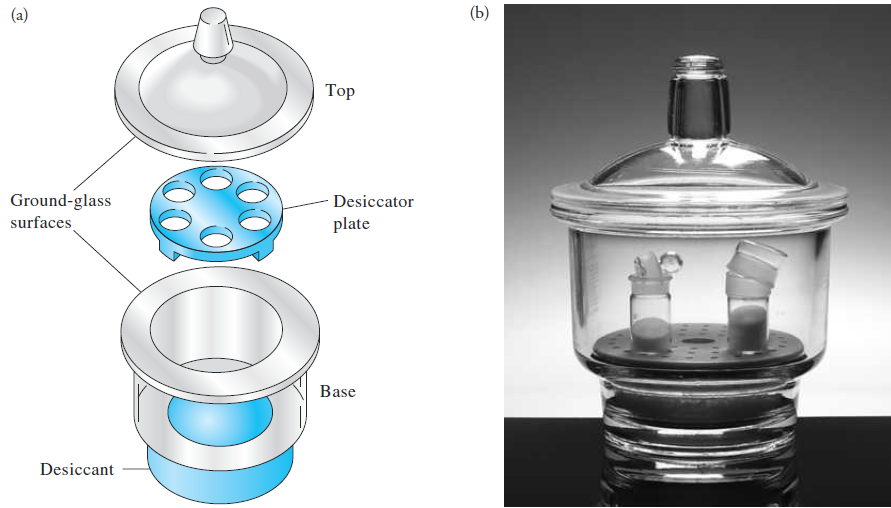


 علم الكيمياء
علم الكيمياء 
 الكيمياء التحليلية
الكيمياء التحليلية 
 الكيمياء الحياتية
الكيمياء الحياتية 
 الكيمياء العضوية
الكيمياء العضوية 
 الكيمياء الفيزيائية
الكيمياء الفيزيائية
 الكيمياء اللاعضوية
الكيمياء اللاعضوية 
 مواضيع اخرى في الكيمياء
مواضيع اخرى في الكيمياء
 الكيمياء الصناعية
الكيمياء الصناعية |
Read More
Date: 26-4-2017
Date: 18-4-2017
Date: 4-3-2018
|
Desiccators and Desiccants
Oven drying is the most common way of removing moisture from solids. This approach is not appropriate for substances that decompose or for those from which water is not removed at the temperature of the oven. To minimize the uptake of moisture, dried materials are stored in desiccators while they cool. Figure 1.1 shows the components of a typical desiccator.

Figure 1.1 (a) Components of a typical desiccator. The base contains a chemical drying agent, which is usually covered with a wire screen and a porcelain plate with holes to accommodate weighing bottles or crucibles. (b) Photo of desiccator containing weighing bottles with dry solids.
The base section contains a chemical drying agent, such as anhydrous calcium chloride, calcium sulfate (Drierite), anhydrous magnesium perchlorate (Anhydrone or Dehydrite), or phosphorus pentoxide. The ground-glass surfaces between the top and the base are lightly coated with grease to ensure a good seal when the top is in place.
When removing or replacing the lid of a desiccator, use a sliding motion to minimize the likelihood of disturbing the sample. An airtight seal is achieved by slight rotation and downward pressure on the positioned lid. When placing a heated object in a desiccator, the increase in pressure as the enclosed air is warmed may be sufficient to break the seal between lid and base. Conversely, if the seal is not broken, the cooling of heated objects can cause a partial vacuum to develop. Both of these conditions can cause the contents of the desiccator to be physically lost or contaminated. Although it defeats the purpose of the desiccator somewhat, allow some cooling to occur before the lid is seated. It is also helpful to break the seal once or twice during cooling to relieve any excessive vacuum that develops. Finally, lock the lid in place with your thumbs while moving the desiccator from one place to another.
Very hygroscopic materials should be stored in containers equipped with snug covers, such as weighing bottles. The bottles remain covered while in the desiccator. Most other solids can be safely stored uncovered.



|
|
|
|
دخلت غرفة فنسيت ماذا تريد من داخلها.. خبير يفسر الحالة
|
|
|
|
|
|
|
ثورة طبية.. ابتكار أصغر جهاز لتنظيم ضربات القلب في العالم
|
|
|
|
|
|
|
العتبة العباسية المقدسة تقدم دعوة إلى كلية مزايا الجامعة للمشاركة في حفل التخرج المركزي الخامس
|
|
|